"There is also an amplitude for light to go faster (or slower) than the conventional speed of light. You found out... that light doesn't go only in straight lines; now, you find out that it doesn't go only at the speed of light! It may surprise you that there is an amplitude for a photon to go at speeds faster or slower than the conventional speed, c." -Richard Feynman
You've been around the block a few times, and you know how it goes when you try to go faster and faster. Everything works just like you expect, until you start getting close to the speed of light, c. And then, all sorts of weird things start happening.
Lengths contract, clocks run slow, and the more and more energy you put into the system, the faster it moves!
Only, it can never reach the speed of light. It can approach the speed of light, but it will never reach it. In fact, no matter how fast an object moves, it always sees light moving at c, the Universal speed of light.
But we're very clever. If we can't make things with mass even go at the speed of light, much less faster than it, perhaps we can go in the other direction: slow light down.
This is easier than you think; all you need is some sort of non-vacuum to pass light through! (Every Pink Floyd fan should know how to do this.)
After all, even though you can't go faster than the speed of light in vacuum, there's no law saying you always need to be in a vacuum. So what can we do? Perhaps we can create a particle (like an electron) in some nuclear reaction that's moving close to the speed of light in vacuum, and then make it enter a medium, like water, glass, or acrylic!
What happens now, if the particle -- moving slower than c -- goes faster than light in some medium?
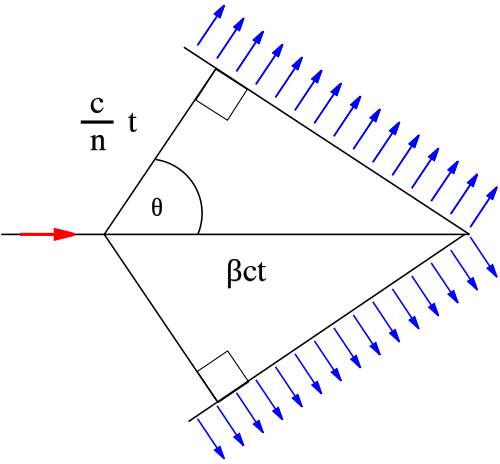
Amazingly enough, the particle freaks out, and starts emitting light. The light is very special, and comes off in a particularly cone-like shape, and is the particle's way of trying to shed that extra energy until it gets down safely below the speed of light! The light is called Čerenkov radiation (pronounced and sometimes-lazily-spelled Cherenkov), after its Nobel-prize-winning discoverer.
It's almost always high-energy light, so that if any part of it appears visible, it's in the blue end of the spectrum. In fact, if you go inside your nearest nuclear reactor, you're likely to see a bluish glow.
So that's what happens if you move faster than the speed of light! Some particles, like cosmic rays, move so close to c (we're talking with millions of times the energy we can create at the LHC), that even the atmosphere, where the speed of light is 99.97% of c, can produce Čerenkov radiation!
Now, for those of you who are science fiction fans, the gears might be turning in your brain. "What about," you might ask, "a Tachyon?!" What about theoretical particles that move not slower than light, nor at the speed of light, but faster than c?
If such a thing as a tachyon exists, shouldn't it emit Čerenkov radiation, and therefore be detectable by the Čerenkov light it emits?
It turns out that the answer is no, for some surprising reasons. Let's think about these three classes of particles: the slower-than-light ones, the at-the-speed-of-light ones, and the tachyons.
- You move slower-than-light if you have a real, positive mass. Nothing with mass can ever reach or exceed the speed of light in vacuum; that would take an infinite amount of energy, and that's why c is the speed limit of the Universe. If you move faster than light-speed in a medium, you'll emit Čerenkov radiation until you're moving slower than light-speed in that medium.
- If you move at the speed of light, that means you have zero mass. Relativity doesn't really give you much choice; that's the speed you travel at. This means you move at c in vacuum, you move at whatever the speed-of-light-in-media is when you're not in vacuum, and that's it.
- But if you move faster than light, something's got to be different. Your first guess might be that you have negative mass, but that's not quite right. Negative mass would still mean that you're just like normal matter, except you're not a real particle; you're a virtual one. If you want to be a tachyon, you need something even more ridiculous seeming:

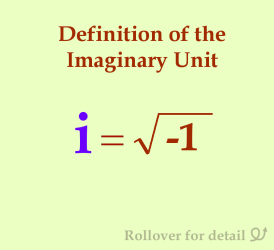
And it turns out that a tachyon, with its imaginary mass, moving faster-than-c is just like a normal, massive particle, moving slower-than-c. In other words, a tachyon traveling faster-than-light through a vacuum would be just fine, just like a normal particle would be fine moving slower-than-light. No emitted radiation, no changing of its speed, nothing like that at all.
In other words, a tachyon wouldn't spontaneously just emit Čerenkov light, or produce a show like the above image.
But let's say you're really gung-ho about this, and wanted to know what could cause a tachyon to emit Čerenkov light. Well, learn relativity and quantum field theory, and you can figure it out!
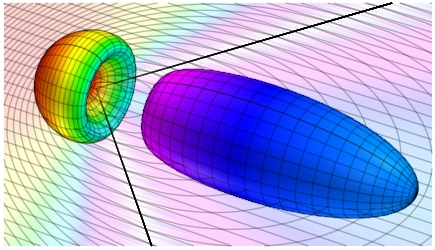
What it takes -- assuming your tachyon exists and is electrically charged -- is to find a medium where the speed of the tachyon is smaller than the speed of light in that medium! That will force you to emit Čerenkov light, and as you do, your tachyon will gain speed until it goes back to its "normal" state: moving faster than the speed of light!
And that's all you need! In theory, if there are charged tachyons zipping around through space and we just haven't seen them, building just the right kind of material with the right index of refraction could allow us to detect them! And now you know a fun result that many theoretical physicists botch: tachyons don't emit Čerenkov radiation unless they move slower-than-light in a medium!
- Log in to post comments


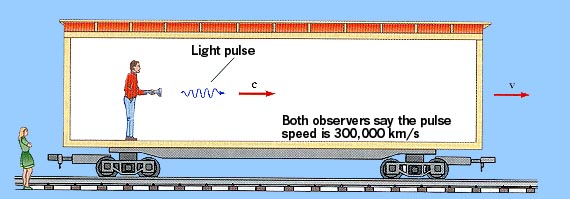


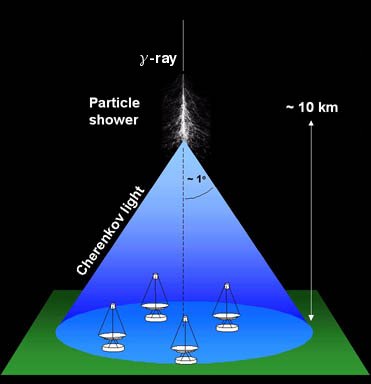



Does this mean that the theoretical medium should give the tachyon some energy to speed it up to its "idle" speed?
What I don't get is that the tachyon will at the same time:
- emmit a Äerenkov radiation (<=> loose some energy)
- gain speed (<=> gain energy?)
How can it do both at the same time?
This is easily my favorite post you've written so far. Nice work.
To guess at an answer to xgbi's query: if the mass of the tachyon is imaginary, perhaps the energy (gained/lost) would also have some imaginary type component which would make the math work.
The resolution to the paradox xgbi@1 raises is that for a tachyon, lower energy means a higher speed. The momentum p of a particle with rest mass m0 moving at velocity v is γ * m0 * v where γ = 1/sqrt(1-v^2/c^2). If v > c then γ is also imaginary, so the momentum will be real. Its magnitude as v goes to infinity approaches |m0| * c, and as v approaches c from above the momentum goes to infinity just as it does for real matter. The energy of a particle is given by E^2 = c^2p^2 + m0^2c^4, which goes to 0 in the limit of infinite velocity and is positive for any finite velocity.
The mathematician in me wants to scream at that definition of i, but I'm just being difficult I suppose. Excellent article.
The baseball would also appear to rotate, not just length contract.
Zach: How else would you define i?
Ethan: So, in other words, you just need a medium in which the speed of light is higher than it is in a vacuum?!
Nemo: i^2 = -1. It's a much better definition just because it is clearer that not i = â-1, but ±i = â-1.
Yes, most people know that old plus-minus thing, but you'd be surprised how many times I've seen "zomg wolfram alpha sayz that â-1 is i, not -i u ideot".
And if a particle has complex mass/energy with both real AND imaginary parts?
@Zach:
Wow, you are ridiculously wrong. i = \sqrt{-1}. In the complex plane, i has coordinates (0,1). If you don't know anything about mathematics, don't pretend to be an expert.
@Lotharloo, Zach is right. \sqrt is ambiguous for complex numbers.
Correct me if I'm wrong. "Light" only travels in a vacuum and it only travels at c.
The "speed of light" through a medium is actually the speed at which the photons are absorbed and re-emitted as they travel through the medium.
I've always wondered about this question but have never met anyone that could answer it properly: If, as an object approaches light speed, time dilation "slows" an object's speed from the perspective of an outside observer, what is the fastest an object can travel before it appears to be slowing down to an outside observer?
I'm probably misunderstanding this concept, but any help would make this English Major very happy.
@Matt: 0 m/h. Anything faster than that, and it starts slowing down, from outside observers' points of view.
How fast it can go before the time dilation becomes measurable depends completely on the accuracy of the instruments being used to measure, of course.
Zach's right, "i = â-1" is fine if you're an engineer or a scientist, but to a mathematician, it's anathema... square root is not defined for negative numbers, and using the complex plane to define it would be circular (because the complex plane is a direct result of i). And so the definition used in mathematics is "i² = -1", because that equation is composed entirely of clearly defined terms.
So is there some reason to think that the Tachyon exists or is it just one of those fun possibility's that physicists like to play with? I mean the chance that a particle with imaginary mass exists is bad enough but if one was out there and we knew for sure it was just a matter of making a bottle to catch it my holy sh** gland might blow out forever.
In a "let them eat cake" world one man says: No way! and serves 16oz. Rib Eye steaks with all the trimmings.
Thank you, Sir.
Very interesting post indeed. Imaginary mass is cool, but what can you tell us about imaginary time? I've heard it mentioned before but I don't know what the implications are and would love to hear an explanation that I can actually comprehend.
The picture showing the future and past light cones is slightly misrepresented. Our past light-cone actually bends in on its self (if u go back far enough), and thus it's pear shaped and not cone shaped as shown.
So...the real question is how to produce an imaginary mass.
Any suggestions?
This post is awesome.
very informative.
I think the first picture with the tennis ball Lorentz-contracting is wrong. It is known that spherical objects get mapped to spherical ones under Lorentz-boosts. What will happen is that you'll see the back of the tennis ball.
Also see: http://en.wikipedia.org/wiki/Penrose-Terrell_rotation
Writing anything but ЧеÑенков would be lazy, all other spellings is just up to your choice of transliteration, no? Although I consider myself quite fluid in English, it's not my native tongue, so you might have a more valid opinion. My Swedish transliteration is anyways Tjerenkov.
This post needs a theme song.
http://www.youtube.com/watch?v=0TWR3u8shhg
The really interesting thing about tachyons is that they actually don't violate causality. Solutions of the tachyonic Klein-Gordon equation come in two kinds: those with packet velocities less than or greater than c. If the packet velocity is less than c, the field doesn't transmit a signal (information) any faster than light, and if the packet velocity is greater than c the solution cannot be compactly supported. That is, the signal might move faster than light, but nobody can actually send such a signal, so still no information can be communicated faster than light!
Interesting post. You may be right that charged tachyons do not emit Tjerenkov radiation, I've not worked out the details. But your argument is unconvincing. Maxwell's equations are pretty unequivocal, are they not? Their (causal) solution indicates that there is such radiation. The e&m radiation carries off forward momentum and energy, and the tachyon ( that has positive energy, and momentum in the direction opposite to its motion) loses energy and accelerates. At infinite speed the tachyon's energy and momentum are zero. Thus most cosmic tachyons would be expected to be going infinite speed as they have likely radiated away all their energy.
Best Cerenkov radiation and tachyon explanations I've read. Thanks.
Are a hypothetical tachyon's time, energy, and momentum also imaginary number quanties? I think so, but not sure.
Further, if we assume velocity to be an imaginary quantity; is there an accepted hypothetical name for such a particle? And do such hypothetical particles have time, energy, mass and other hypothetical physical quantities that are quaternions or octonions? And do such hypothetical particles show up in the ideas of string theory?
Oops sorry, one other subthought question.
E= mc^2 and since a tachyons mass is an imaginary number quantity; it seems that its energy E would also be an imaginary quantity. And if all of a tachyon's energy states are imaginary quantities; then wouldn't the photons being emitted by a tachyon also have imaginary energies to raise or lower the imaginary energy states of a tachyon. So, how would we hypothetically detect photons of an imaginary number energy level? Would that detection, maybe be, very difficult in our real number quantity visible universe? It would seem to me that some indirect experimental detection trick would be needed.
In this question, I just want to understand Ethan's explanation. Just tell me if my thinking makes sense or if I'm confusing something in Ethan's description. I'm not offering an alternative description or interpretation.
The "figure it out" link is restricted access; I won't be paying $34 to read the paper.
"Correct me if I'm wrong. "Light" only travels in a vacuum and it only travels at c."
No, it also interacts with matter. And that slows it down.
A previous post by Ethan went into this.
"E= mc^2 and since a tachyons mass is an imaginary number quantity; it seems that its energy E would also be an imaginary quantity."
m is relativistic mass, not rest mass and a tachyon has imaginary speed, real energy and nothing in Ethan's post seemed to mention "mass" of a tachyon being imaginary. Just that its velocity would be.
Since it has real energy, it can lose photons with real energy too. Doing so would speed it up, however. But it would be real, not imaginary.
Wiki explains why tachyon energy is real when mass is imaginary. ditto momentum.
But looking at the Lorentz transformations , yikes, it looks like time and space might be imaginary quantities; since the Lorentz factor is imaginary. What am I missing?
My mother has an imaginary mass, which is to say I have no idea where she gets it from but it's definitely not a scale.
Just about everything in this article is wrong, but I don't really care to argue about it. There are no tachyons, not even in principle. The geometry of the world is what it is, and nothing goes faster than C. Period. There is no imaginary mass. Period.
-drl
.. and oh by the way, a moving baseball always appears spherical, no matter how fast it's going or on what path. This was shown by Penrose, and Terrell, and independently as a student, by myself (among many others I'm sure). You should not be teaching people something that you yourself do not understand.
-drl
@WOW
"...nothing in Ethan's post seemed to mention "mass" of a tachyon being imaginary."
But Ethan said:
"M^2 <0"
"You need the square of your mass to be less than zero, which means you need an imaginary mass!"
This is one of my favorite blogs. Great Job!
This talk about light in a medium is fascinating and begs a question. Could dark matter be considered a medium?
thx -gary-
To all: Tachyons are tacky - they do not exist, not only because the geometry of the Minkowskian world does not allow them, but also because they cannot interact with bradyons (normal matter going at <= C). When something is posited in physics that is inconsistent, then either the framework is wrong, or what is posited is wrong, and since it is guaranteed that the framework - Minkowski geometry in the local area - is right, then the posited idea of things going > C is itself wrong. There are no tachyons, period - end of story - you might as well look for unicorns and leprechauns.
-drl
Short answer: no.
Afrika kıtasının güneyinde yer alan 15 ülkenin üye olduÄu SADC ülkelerinin toplam nüfusu yaklaÅık 250 milyon. Zengin petrol, altın ve elmas madenleriyle Dünyanın en hızlı geliÅen 10 ekonomisinden 7âsinin bulunduÄu bölge, öte yandan erken ölümlere neden olan AÄ°DS virüsünün en yaygın olduÄu yer
We all know that Rayleigh scattering causes the sky to be blue,
Wiki; Rayleigh scattering) is a function of the electric polarizability of the particles.Rayleigh scattering of sunlight in the atmosphere causes diffuse sky radiation, which is the reason for the blue color of the sky and the yellow tone of the sun itself.
yet, is that a complete answer?
In the past, Science was a competition (and for some it still is)and who ever made the better argument and followed the Scientific method the closest, and offered correct predictions, won out, but times are changing, sometimes there can be more than one answer correct to their specific percentage within their operating parameters.
Not saying this is one of those situations...yet consider this,
What about energetic charged subatomic particles originating from outer space?What do they contribute?
What fraction of the percentage is due to Cerenkov radiation?
In he 70's the astronauts of that time noticed that every 3 minutes or so, a white or blueish light was detected and NASA built a helmet incorporating sensors to determine if the effect was an inner effect or from the outside, it was from Cosmic Rays, (Wiki-Cosmic ray visual phenomena)
*WOW, it.s getting to be you can find anything on Wiki*.
Anyway, it may be trivial (a minor result) yet is it part of the answer...maybe?
And if it is then it should be determined, what percentage do we owe our blue sky to Cerenkov radiation?
In other words how much of the blue is from inner solar system and how much from outer space? if any, will it be measurable?
Science should always strive for the complete answer and leave no stone unturned.
I can't wait to see data from the AMS-2, I'm nawwing at the bit, as they used to say.
The amount of energy necessary to take a mass from 0 to 93,000 miles per second is the same necessary to take the same mass from 93,000 to 185,000 miles per second. All this giberish about not being able to exceed the speed of light is fruitless. There are several forces that exceed the speed of light.
@ Todd
Don't leave us in suspense Todd. Give us a few gems from your Nobel Prize winning paper on the New Physics.
> In the past, Science was a competition (and for some it still is)and who ever made the better argument and followed the Scientific method the closest, and offered correct predictions, won out,
The "followed the scientific method the closest" HAS NEVER BEEN a factor in "winning" for a theory in science.
NEVER.
"Correct predictions" is closer, but far more correct is "Useful predictions".
The Bohr model of the atom was wrong (accelerating electric charges give off EM waves and lose electricity and would spiral in to the atom), but gave MORE USEFUL predictions than the "plum pudding" model that was its competition (among others).
"Not saying this is one of those situations...yet consider this,
What about energetic charged subatomic particles originating from outer space?What do they contribute?"
The contribute nearly bugger all. Compared to the solar wind, even (whose energy density is naff all compared to the TSI from non-particulate photons).
As to their contribution to the blue sky?
Absolutely nothing.
"What fraction of the percentage is due to Cerenkov radiation?"
Nil.
"Anyway, it may be trivial (a minor result) yet is it part of the answer...maybe?"
Only in as much as maybe the colour of the eyes of blue-eyed nordic peoples has increased the number of blue photons in the sky.
As in: not at all.
"Science should always strive for the complete answer "
NO.
NEVER.
Science doesn't deal with "complete answers". It deals with USEFUL answers.
We KNOW photons aren't particles, yet when we want to devise a CCD detector, the science that does so model photons is useful where the one that models them as a plane wave doesn't.
Science knows we will never know TRUTH. But it intends to find out how we can explain what is happening. And as long as it can do so, it remains true enough to live by. But because it's useful, it can easily be replaced by something even more useful later on.
It's why science IS NEVER a religion. A religion insists it has THE TRUTH. And once having had the truth CANNOT EVER CHANGE.
Science is the search for truth, but the things we find are purely useful. Truth is something we leave up to the universe to have.
"You need the square of your mass to be less than zero, which means you need an imaginary mass!"
Imaginary rest mass.
But it isn't at rest. A particle at rest isn't going faster than light and therefore cannot be a tachyon.
The energy is still positive.
Fenerbahçe, Süper Ligâin son haftasında deplasmanda Sivasspor ile yapacaÄı maçın hazırlıklarını tek antrenmanla sürdürdü. Sarı-lacivertli takımda kapılar dıŠdünyaya kapandı.
Wow, you seem pretty sure of yourself.
So in effect your saying since we found something useful we should stop looking? Seems kinda asinine.
Sounds kinda fishy, you say religion is the search for truth and then you say we'll just leave that up to the Universe, just what are you implying here.
Wow, just because something can be useful does not exclude it from further study.
Why would tachyons not absorb (as opposed to emit) Cerenkov radiation from the medium in which it's traveling slower than c to gain energy?
Can someone elaborate on @John Armstrong's comment about sending information this way (being impossible)? My first reaction to the post was "But then you could send information FTL!" (you don't even have to make tachyons -- just use a tachyon-slowing prism).
@Larry O'Brien:
First of all we haven't ever actually identified any tachyonic particle; none of the particles in the Standard Model are tachyonic, and there's no real evidence we ever will find one. Still, we can write the equations down and so they make for a convenient mechanism for science fiction writers.
THAT SAID: the simplest solutions to the Klein-Gordon equations are "plane waves". These are a field excitation like f(t,x,y) = sin(t-x). This one describes an infinite wave train that extends the entire length of the y axis, traveling in the direction of the x axis at a certain rate, and with a certain fixed distance between the waves. The fixed distance is the "wavelength" and the rate that the train moves is called the "phase" or "wave velocity".
The problem is we can't actually send this as a signal because it's EVERYWHERE. Real signals have a starting time (when we send them) and have to start out in a small area (the transmitter). But the nice thing about the Klein-Gordon equation is that we can add together solutions to get other solutions. Real E-M signals (like radio waves) can actually be written as a "packet" of plane waves all added together to make something that does behave like we need it to. The catch is that now this packet doesn't necessarily travel at the same rate that the constituent waves do. Instead it moves at the "group" or "packet velocity". This is USUALLY the same as the velocity of a signal carried by the packet, but it's possible for the signal velocity to be slower in very special circumstances.
So what happens if you try to make packets out of a tachyonic field? one of two things: either the packet velocity is greater than c, in which case the packet is not compactly supported and thus can't actually be created and sent as an information-carrying "signal"; or it's less than c, in which case any information it carries is traveling slower than light even though the constituent particles are traveling faster.
"Wow, you seem pretty sure of yourself.
So in effect your saying since we found something useful we should stop looking? Seems kinda asinine."
You seem pretty sure of yourself.
No, that isn't the effect of what I'm saying.
You can no more get a tachyon to go at c or any velocity below it than you can get a matter particle up to c.
Therefore, BY DEFINITION, a tachyon is going faster than c.
If you want to accelerate "something" up to beyond c, I.e. "create a tachyon", it would have to start with imaginary rest mass.
However, if you already have a tachyon, it's mass is positive.
Think like this: you CANNOT get a photon that isn't moving.
So when you emit it, what speed is it going? When it's absorbed, what speed is it doing?
But the problem there is that the photon doesn't exist, by definition after it's absorbed or when it is about to be emitted. And before absorption and after emission, it's going at c.
So I only seem sure of myself in comparison to people who say "in effect" and then tack on something they invented, ascribed to me.
It's pretty easy to be sure that's wrong.
"Why would tachyons not absorb (as opposed to emit) Cerenkov radiation from the medium in which it's traveling slower than c to gain energy?"
It would be going faster, but be lighter.
If it could.
But the photon would be absorbed only if it were going away from the tachyon and could be being absorbed before it was emitted. But then it wouldn't exist to be emitted. So it wouldn't be absorbed. So it could exist after all... Head Boom.
Not necessarily impossible, but you have to be careful and you're looking at a Feynman diagram to work out the causal relationships to see if they are still valid physically, which is well beyond me.
Wow, there seems to be a miscommunication, I did not address tachyons and in case you thought this
*WOW, it.s getting to be you can find anything on Wiki*.
was a communication towards you...it wasn't, it was my poor form of expression.I think we got off on the wrong foot, my only attempt with com 39 was to point out that not all science is cut and dry and should be continually revisited with the benefit of advanced knowledge that has been gained since last questioned, capiche?
This is all great, I really love this article, but I just have one question. If a piece of matter can exceed the speed of light in a medium, then why can't it exceed the speed of light in a vacuum?
I think the speed of tachions is exactly c ,ie, the speed of light, only the average speed will be greater than the speed of light. Only one condition for this is, that the tachions just move away or just be able to approach the observer relative
re 52: because light goes slower depending on the refractive properties of the medium.
Electrons, for example, aren't refracted, so are unaffected.
Making electrons go faster just means putting more energy in and if the medium slows the electron by some value, at some energy of electron for some frequency of light, that electron will be going faster than light.
Put more energy into a photon, however, and it won't go faster. Just gets bluer.
this is so neat: http://holographicgalaxy.blogspot.com/
We wonder if anything can go as fast as light; here is the particle. Graphene and Hydrogen and Carbon Mono make carbon nanos. Graphene is the organizer of electricity and magnetism in space; this is the big WOW we have been waiting for. Electrons in a vacuum move at speeds close to SOL. Carbon nanos produce liquid water in space at zero temp.
We don't need imaginary experiments and particles.
I know you are all going to love this...
...so if nothing composed of 'mass' can travel faster than c
...but imaginary mass ('i') always travels faster than c
...what if we are composed of 'i' confined to 'mass'
...what if when we lose our 'mass' (at physical death), our 'i' is released from space/time constraints and we enter into eternity?
...what if all we suspect is actually there, true & concrete, but cannot be measured or reached through human striving, enterprise, intellect or scientific progress?
"God has set eternity in the hearts of men, though they cannot fathom it."
Ecc 3:11
...What if we are missing the forest for the trees?
"I tell you the truth, anyone who will not receive the kingdom of God like a little child will never enter it."
Mark 10:15
...What if we just accept that the 'other' or 'i' is described as heaven in the bible, we'll go there when we die, and having accepted that we can't force our way in from this end, learn more about the one who actually created e, m, c, i and U!!
"...what if we are composed of 'i' confined to 'mass'"
Um, why is i confined by Mass at all? It would need to interact with Mass and therefore it would be detectable.
Imaginary mass isn't detectable by definition.
"...what if when we lose our 'mass' (at physical death)"
We don't. Weigh a corpse. Put it in a sealed container. Weigh it when it's well decomposed.
It still has weight.
"...What if we just accept that the 'other' or 'i' is described as heaven in the bible"
What if we just accept that invisible pink unicorns eat our socks?
Spirit/soul (i) contained within body (mass)
Spirit/soul (i) separates from body (mass) at death - u LEAVE a corpse and are now solely composed of 'i'
Do u have a body? Yes. Can I measure it/is it detectable? Yes.
Do u have a spirit? Yes. Can I measure it/is it detectable? No.
"What if we just accept that invisible pink unicorns eat our socks?"
I'm no more a scientist than you are a theologian, I'm just suggesting that the two are not mutually exclusive and may in fact be complimentary.
I do not believe that invisible pink unicorns eat my socks because I have no evidence to support this theory.
I believe in an infinite God because I have evidence to support this belief - first-hand, eyewitness accounts (as in the Bible), and personal experience.
However, I will read your thesis if you will read my bible :)
Bibles are just plain gay and so is believing in god, thank you. I'm with everyone here's arguments except the jesus freak.
need help .... what if I was to say we can use light to move solid matter.... i'm just thinking out of the box .... please let me know in simple term ... can it be done?? thanks ...
i just need a little help...thanks again ..please email me back at mrthomasgee@yahoo.com